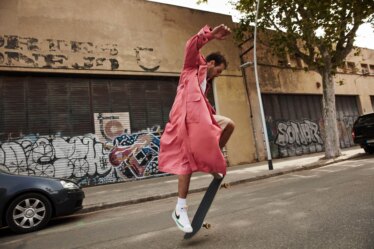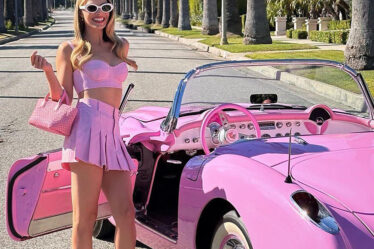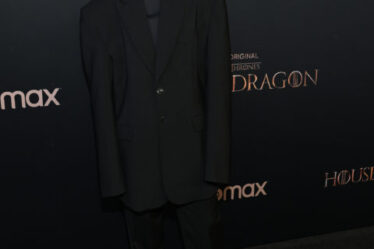
PARIS — Haute Couture Week in Paris began with a blast of the 20th Century Fox fanfare to launch the Schiaparelli presentation on Monday morning. The actors’ strike is over, the red carpet is open for business, and Daniel Roseberry’s extraordinary procession of 21st Century Frocks was designed to capitalise on the reanimated business of show. Muse du jour JLo was backstage in a jacket crafted from real rose petals, their freshness maintained by infusions of sugar water. Such is the attention that haute couture pays to all-consuming detail.
But there was a much more peculiar, thrilling pulse that underpinned the show. In 1877, Elsa Schiaparelli’s uncle Giovanni was responsible for discovering “canals” on Mars. That suggestion of extraterrestrial life inspired him to imagine Martians. We know what happened next. Every which way of alien life fed popular conjecture. And so we arrived at Roseberry’s “Schiaparalien”. As the opening fanfare died down, the ominous throb of the original “Alien” soundtrack took its place. It coloured what followed. Mars attacked. Did the model in the shiny black vinyl dress with the white crochet collar look like an alien among us? Did the huge rounded shoulders, exaggerated hips and extended wingpieces look like a Martian’s efforts to fit with some form of terrestrial femininity? Well, yes. Karlie Kloss marched stone-faced down the catwalk like the Queen of Outer Space, her fringes swaying metronomically in an I-Will-Destroy-You rhythm.
This arcane sci-fi element was at its most intense with the teats that forested several looks. Roseberry muse Maggie Maurer walked in a jersey tanktop and cargo pants, like “Alien”’s Ripley, carrying an alien baby cobbled together from obsolete tech, flip phones, crapped-out circuit boards and such. The “teats” were actually inspired by the knots made in horses’ manes for dressage, but when they appeared, they made me think of Ripley suckling Martians.

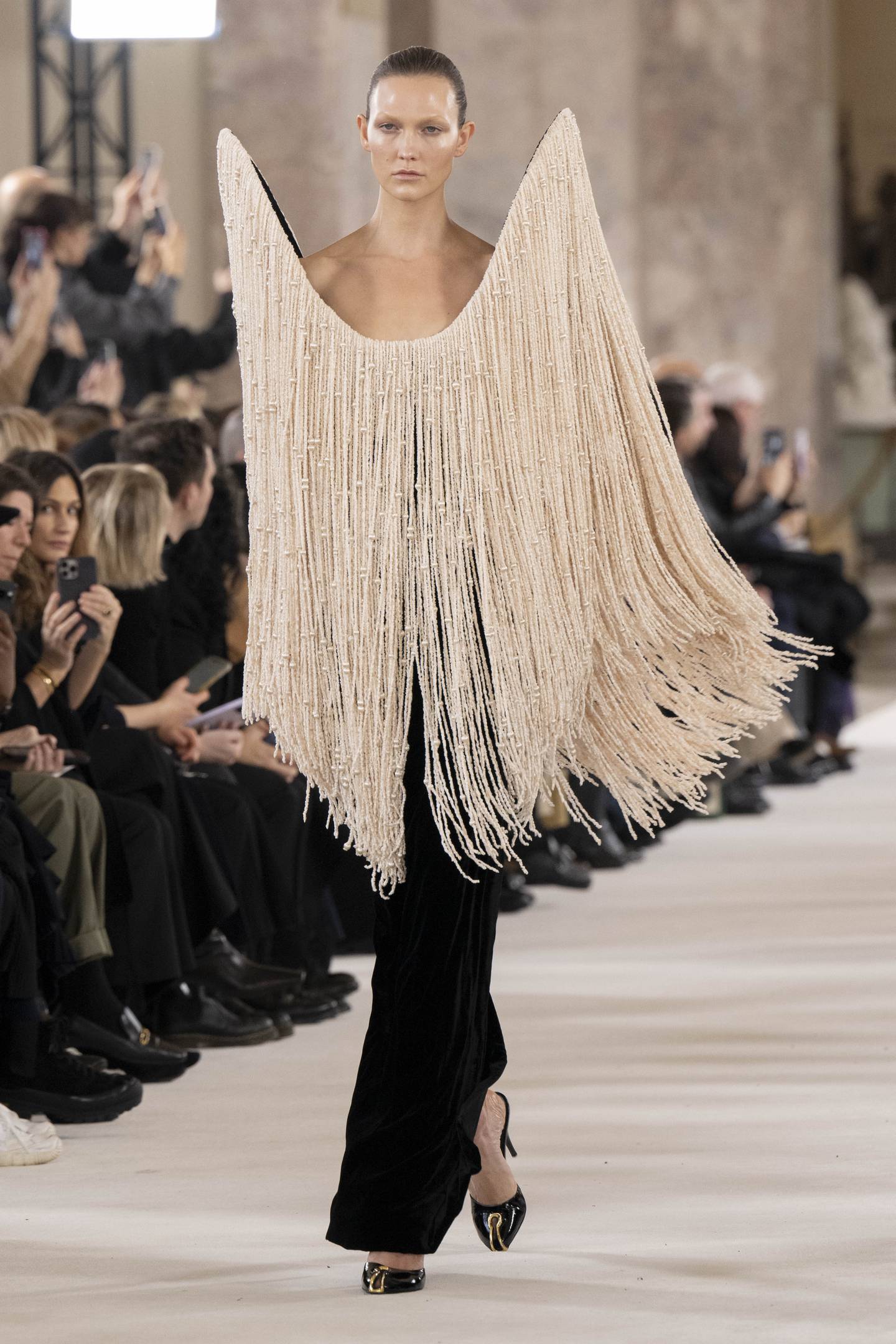
Dressage knots, cowboy buckles, belts and boots. That was Roseberry’s subtext: his own Texan heritage as an American in Paris. Hence the Barbara Stanwyck precision of a broad-shouldered white cotton shirt paired with dark blue denim trousers at one pole, and the showgirl sensationalism of Natasha Poly in her black sequinned bustier with panniers sprouting sequinned fringes at the other. Texas recast as Hollywood. Ultimately, however, this was less interesting than the immaculate sci-fi purity of Roseberry’s couture sculpture: the Brancusi bird perched on one model’s shoulder, the aerodynamic bow shooting out from another neckline. He cited Charles James and Cristobal Balenciaga as references, and their own rigorous otherworldliness seemed particularly appropriate for this collection, especially because Roseberry dispensed with the blatant gold and the anatomical detailing that have been his hallmarks to date (and which were flaunted by many in his audience to varying degrees of agreeability) in favour of something more stately but unsettling, maybe even an acknowledgement of fashion’s current status as an outlier, an alien, in a world gone mad and bad.
You’d never get that kind of twisted notion from a Dior show. But what you do always get from Maria Grazia Chiuri is an occasionally numbing web of philosophical/feminist theorising on which she rests her collection of clothes. Nonagenarian Italian artist Isabella Ducrot was the guru of Chiuri’s latest offering. Her life’s work of researching the cultural importance of textiles all around the world dovetailed not only with Chiuri’s own faith in the empowering aspect of fashion but also with the idea of the aura in art as expounded by the German philosopher Walter Benjamin. Meaning essentially that the aura of an original work will be diluted by reproduction (think of the Mona Lisa endlessly photographed and eventually reduced to a postcard). So PHEW! to all of that. Although Chiuri was adamant that Benjamin’s theory suited couture perfectly: the idea of the unique piece, created for a single client, vs. the industrial production of ready to wear. By way of illustration, she picked out a sleeveless dress in white plissé from her new collection, one single piece of fabric that could only be worked on the body of the client. Yes, she was right about the aura of such an item. It had the still inexplicable mystique of one of Mariano Fortuny’s Delphos dresses from a century ago.
But mystique was less present in the rest of Chiuri’s collection. She had fallen under the spell of moiré, a shimmering silk fabric which has been used throughout history to dress the rich and powerful. So moiré is heavy – leaden almost – with association, and it was no surprise to hear that Chiuri had never considered it before. She said she’d always thought of it as something you’d use in interiors. So why the change of heart?
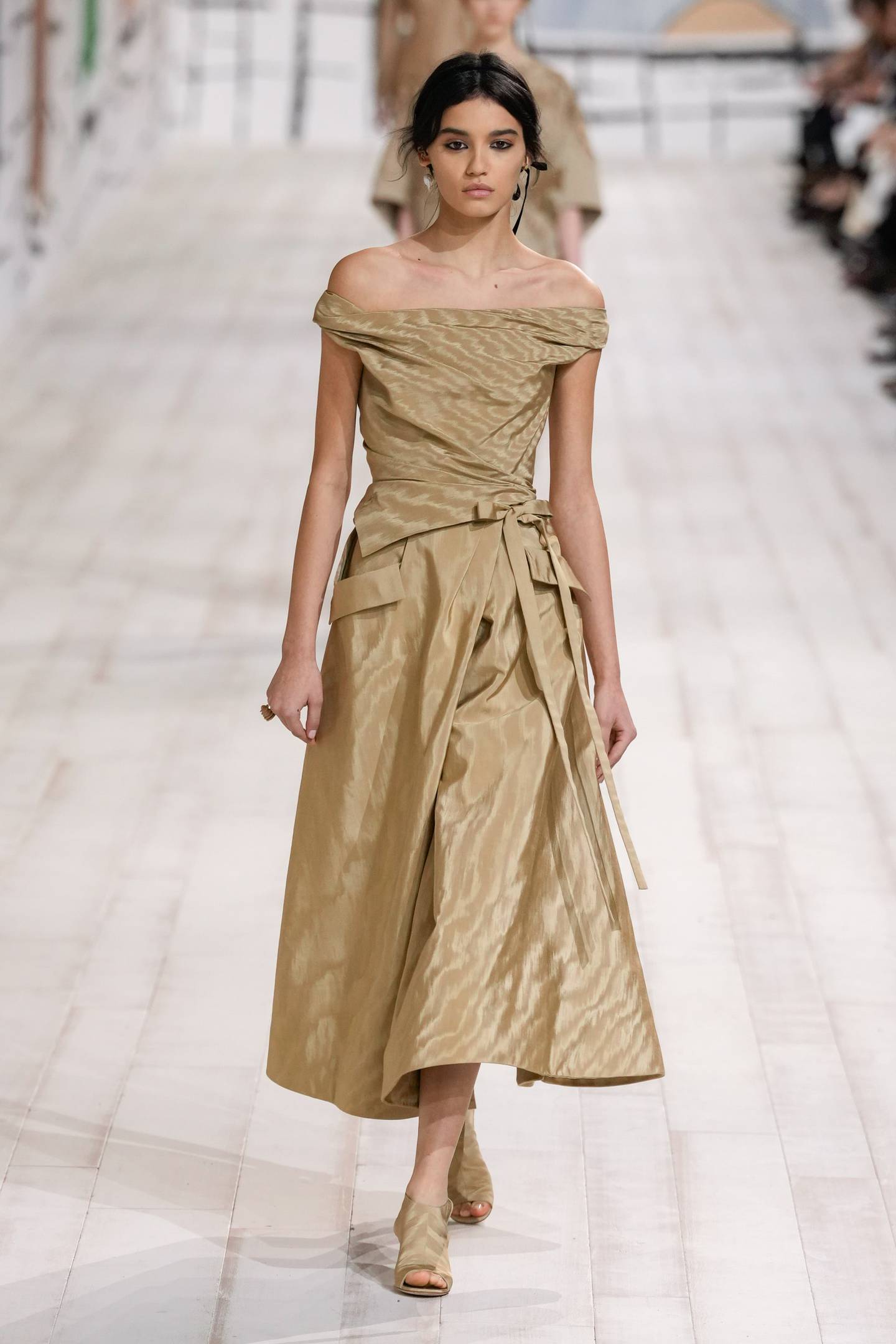
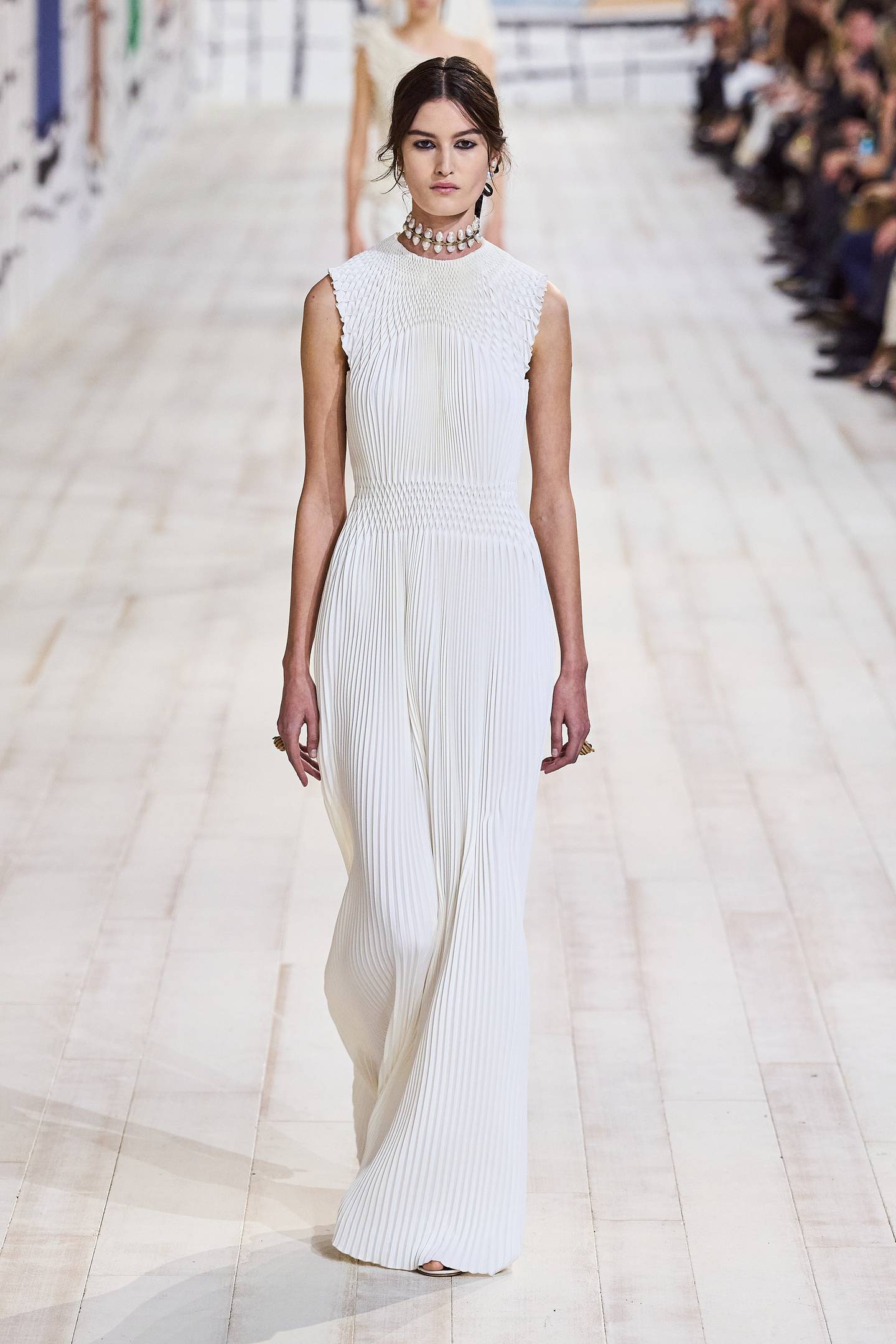
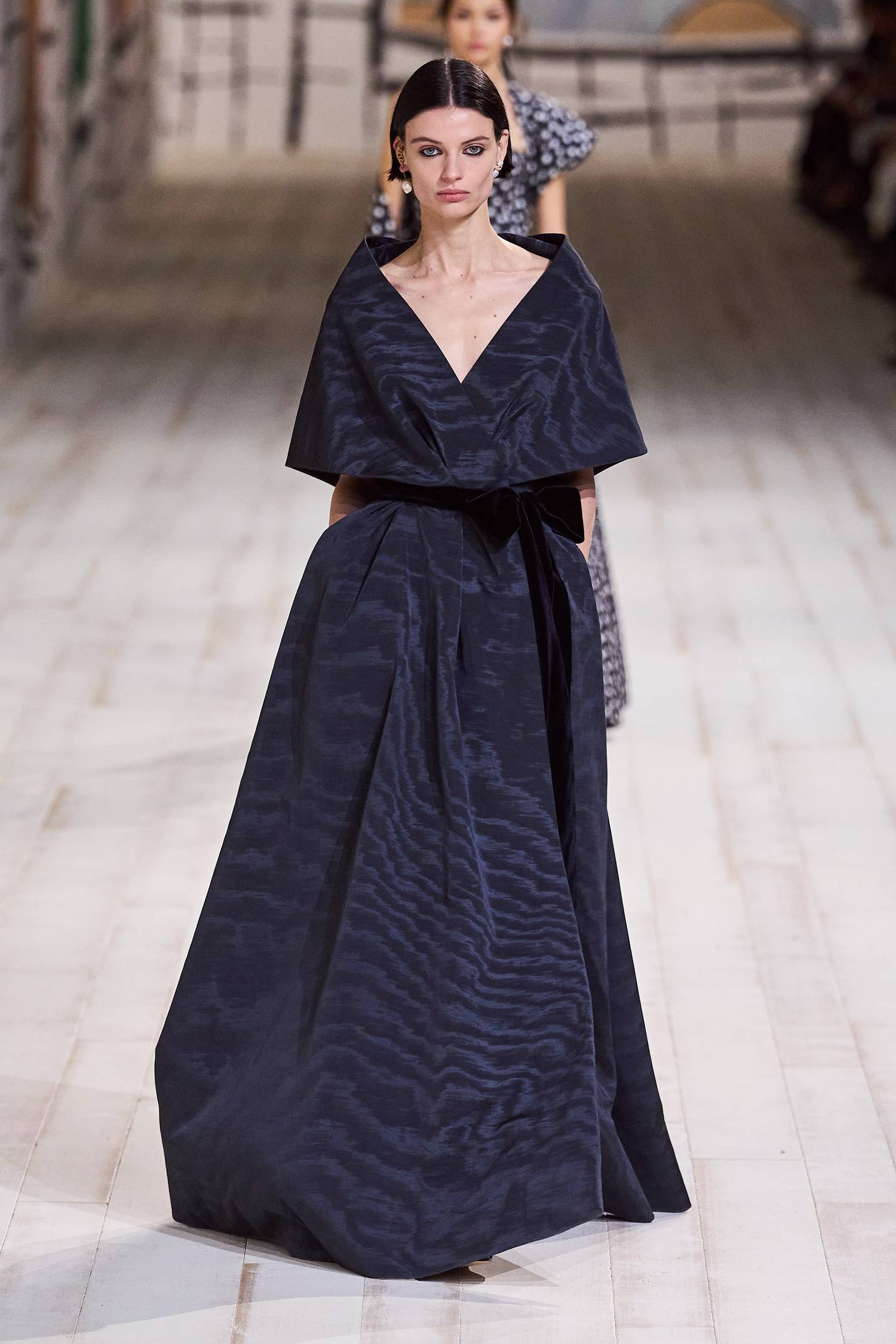
Her rationale was curious. She’d fixated on an original Dior dress style from 1952 called La Cigale, when Monsieur Dior’s fascination with trains, planes and automobiles led him to a more modernist, ergonomic style of design. She somehow imagined this could be made contemporary by using something as traditional as moiré “in conversation” with a modern fabric like silk cotton. Which is nothing you’d imagine the woman who buys Dior couture would be interested in. What she would see here instead would be the old-fashioned shimmer of moiré in rich but Victorian colours, cut into shapes that looked like they’d stepped out of a 1950′s film. The collection was decorous to a fault, solemn, often severe. To appreciate Ducrot’s global discoveries could only make you hope for a little more juice in the Dior offering. Chiuri certainly talked about joyous revelation in her pre-show preamble. It must have turned left at the catwalk.

